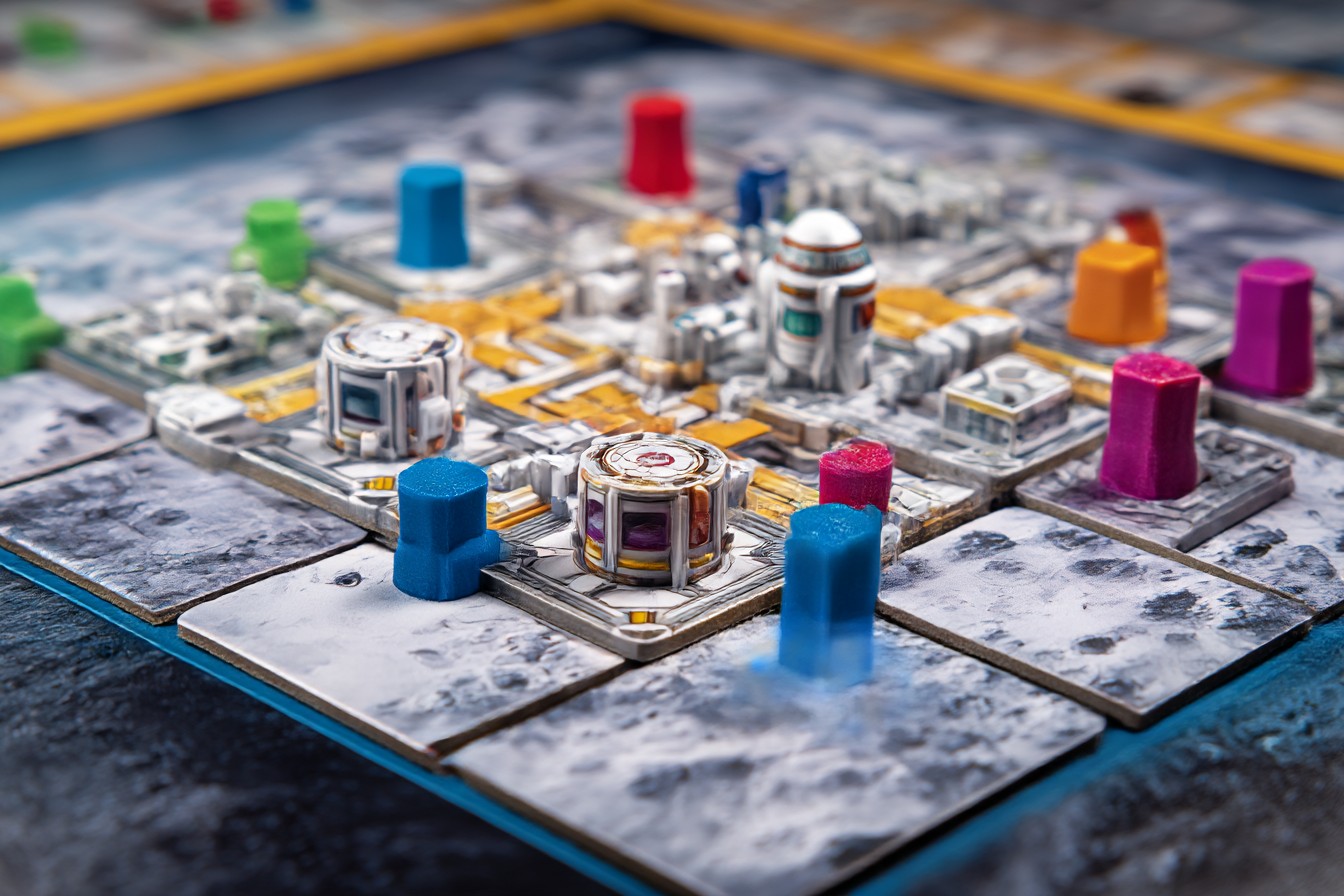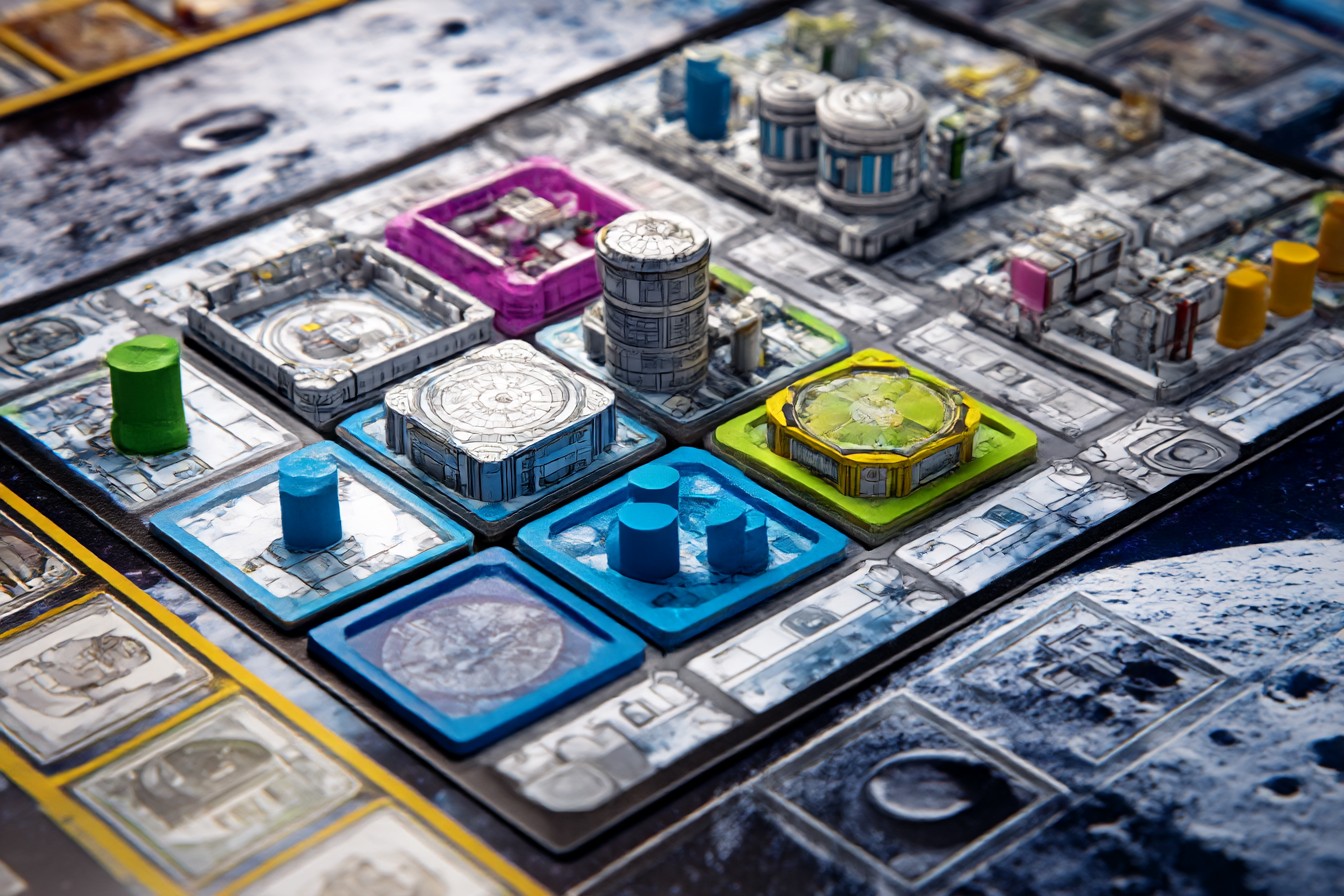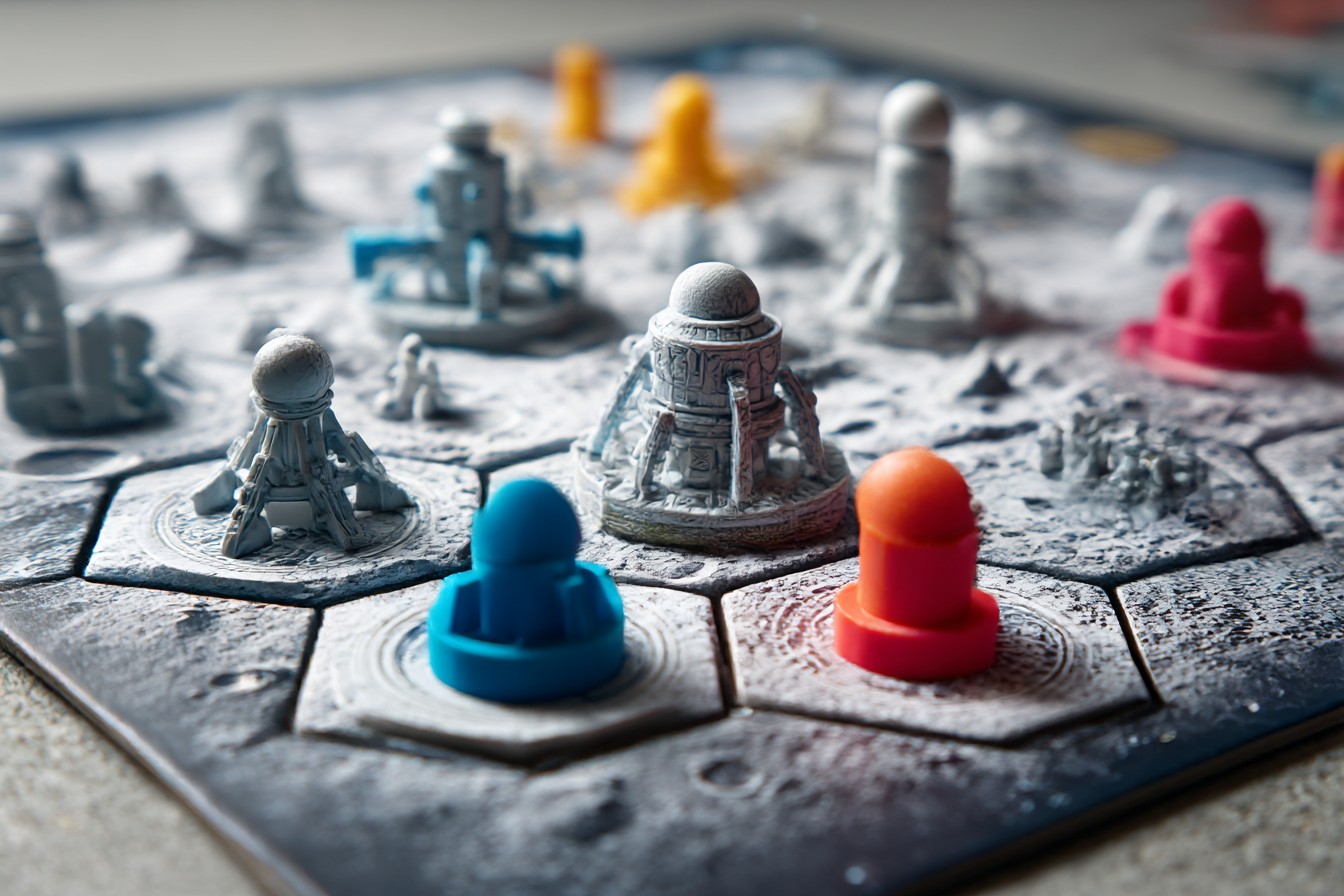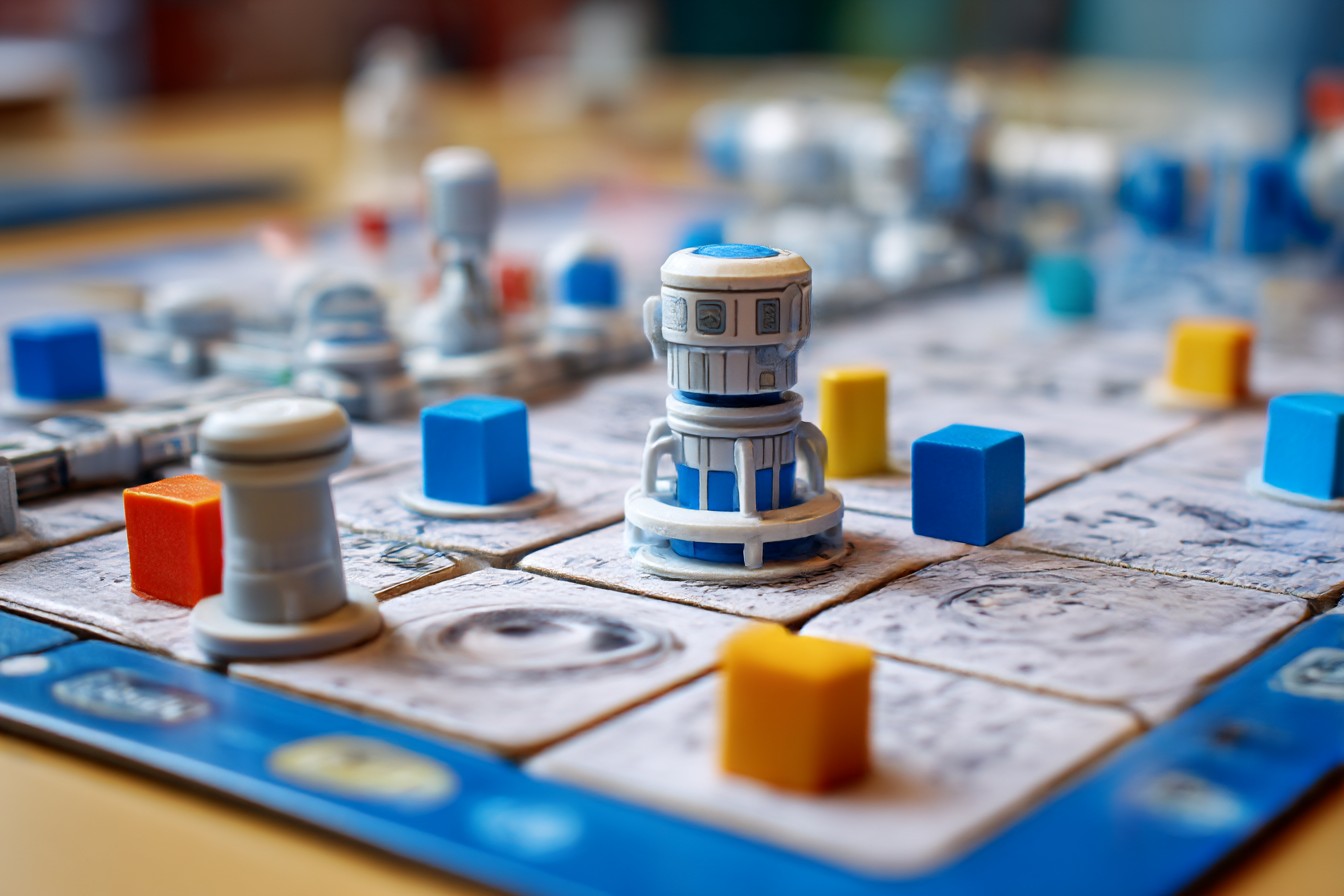I remember the first time I played LUNA Capital at my Tuesday game night. We’d just finished a particularly grueling session of Twilight Imperium that had stretched across the previous weekend (17 hours, if you’re curious, with breaks only for pizza and bathroom visits). Someone—I think it was Kevin from my regular group—suggested “something lighter” and pulled out this lunar colony building game that had been sitting unopened on my shelf for about three weeks.
“Looks pretty straightforward,” I muttered as I skimmed the rulebook while Linda made coffee in the kitchen. “Tile placement with some spatial puzzley bits.” Little did I know I was about to discover one of the most elegantly balanced tableau builders I’d played in years. By the end of that first game, I was already mapping optimal facility arrangements in my head as I drove home. You know how it goes—that particular kind of board game obsession where you’re mentally replaying turns while brushing your teeth.
LUNA Capital is one of those games that seems simple at first glance but reveals surprising strategic depth once you’ve played a few rounds. The premise is straightforward enough: you’re building lunar bases by placing facility tiles and connecting them to resources. But the spatial puzzle of arranging your base for maximum efficiency creates a decision space that’s kept me engaged through dozens of plays.
I’ve now logged 37 games of LUNA Capital (yes, I keep track—spreadsheets are your friend in this hobby), and I’ve developed some approaches that consistently produce strong results. Not that winning is everything, but understanding the underlying structure helps everyone have more fun. At least that’s what I tell my opponents when I’m placing that perfect tile that completes two facility groups simultaneously.
The central challenge in LUNA Capital is balancing immediate point gains against long-term infrastructure development. Think of it like city planning, except on the moon, with considerably less red tape. Though sometimes the competition for certain tiles feels exactly like dealing with a stubborn zoning board.
Let’s talk about facility arrangement first. The impulse for new players (and I was definitely guilty of this) is to grab the highest-value tiles available each round. But that’s like buying the fanciest kitchen appliances before you’ve got electricity installed—impressive but ultimately not functional. In my early games, I’d end up with a collection of valuable facilities that scored poorly because they weren’t properly connected or grouped.
After about my fifth game, I started focusing on creating coherent facility groups first and foremost. The scoring multipliers from completing facility groups are where the big points come from. I played a game last month where Kevin (yes, same Kevin) was collecting all the high-value modules while I focused on creating three medium-sized groups of the same facility type. He had the superior base value, but my multipliers put me ahead by 23 points in the final scoring. He hasn’t let me forget it, bringing it up at every game night since. You know how gaming friends can be.
Resource placement is equally crucial, and this is where I think most intermediate players miss opportunities. Those little resource cubes aren’t just scoring components—they’re the connective tissue of your lunar base. I try to view each resource as serving multiple potential purposes: it scores points for adjacent facilities, yes, but it also creates connections between facilities that might form valuable groups.
In one particularly memorable game (against my son’s girlfriend, who picked up the strategy alarmingly quickly), I managed to place a single resource cube that connected three different facility types, completed a row for mission card scoring, AND fulfilled a blueprint requirement. I may have been a bit too pleased with myself about that one. The girlfriend still beat me by 7 points thanks to some shrewd blueprint selections, which leads me to my next point.
Blueprint selection might be the most overlooked aspect of LUNA Capital strategy. Those cards aren’t just bonus objectives; they’re strategic signposts telling you which direction to build. I’ve developed what Linda calls my “blueprint first” approach, where I select blueprints early that align with a cohesive base design, rather than trying to retrofit my base to match random blueprints later.
This approach backfired spectacularly in a game night about two months ago when the blueprint deck seemed personally engineered to thwart me—I drew three blueprints that required completely different base configurations. I still maintain the shuffle was suspicious (looking at you, Jim from accounting, who was dealing that night). I pivoted to a more flexible strategy mid-game, but the damage was done. Finished second-to-last, only beating Linda who was trying a deliberately contrarian strategy involving minimal resource usage that, uh, needs refinement.
Mission cards introduce another layer of strategic consideration. The temporary scoring opportunities they present can be seductive, but chasing too many missions can fragment your base development. I generally aim to complete 2-3 missions per game, selecting ones that align with my blueprint and facility grouping strategy. Any more than that and I find myself sacrificing long-term scoring for quick points—a trade-off that rarely pays off.
I tracked my mission completion rate across 20 games and found that focusing on row/column completion missions yielded an average of 4.7 more points per game than focusing on the specific facility arrangement missions. Your mileage may vary, of course, but data doesn’t lie (unless you’re using Excel and forget to update a formula, which I have never done, except that one time during the pandemic game marathon when I had been awake for approximately 36 hours).
The rhythm of LUNA Capital is another aspect worth considering. The three-round structure creates a distinct tempo, with different strategies optimal at different stages. In the first round, I focus on establishing the foundation of my major facility groups and securing at least one achievable blueprint. The second round is about expanding those groups and connecting resources efficiently. By the third round, I’m usually filling gaps, completing blueprints, and making final pushes for mission cards.
This three-act structure reminds me a bit of Power Grid’s phases, though obviously with very different mechanics. Both games reward players who can adapt their approach as the game progresses and recognize when to shift from foundation-building to optimization.
If there’s one overarching principle I’ve found for LUNA Capital success, it’s connectivity. Every placement decision should serve multiple purposes, creating a web of interconnected scoring opportunities rather than isolated point sources. A facility that helps complete a group, connects to valuable resources, contributes to a blueprint, AND potentially satisfies a mission card is exponentially more valuable than a high-point tile that sits in isolation.
The spatial reasoning aspect of LUNA Capital scratches the same itch for me as games like Patchwork or Isle of Cats, but with additional strategic layers that keep it hitting the table month after month. My wife has a theory that I’m drawn to these spatial puzzle games because they engage the same part of my brain that handles database relationship mapping in my day job. She might be onto something there, though I maintain that building a lunar colony is far more entertaining than optimizing healthcare records systems (don’t tell my boss I said that).
Temperature management (managing the cold side of the moon) is another wrinkle that separates good LUNA Capital players from great ones. Those temperature restrictions can feel punitive at first, but I’ve come to view them as beneficial constraints that force creative solutions. Sometimes limitations breed innovation, both in game design and gameplay.
I’ve been meaning to do a full statistical analysis of winning strategies across player counts—my preliminary data suggests that resource-heavy strategies perform better at lower player counts, while facility grouping becomes more dominant with more players—but Linda has suggested that might be “taking things a bit far” and “possibly concerning the new people we invited over.” She may have a point. Maybe.
So there you have it—a glimpse into the strategic landscape of LUNA Capital from someone who’s spent far too many hours contemplating optimal moon base construction. If you take anything away from this, let it be the importance of viewing your base as an interconnected ecosystem rather than a collection of isolated scoring opportunities. Also, never trust Jim from accounting when he shuffles the blueprint deck. Just saying.




Leave a Reply